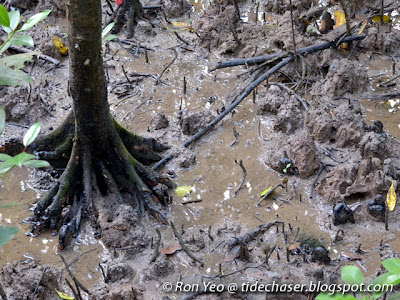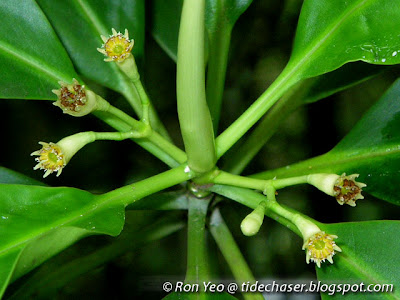The Lenggadai (Bruguiera parviflora) is a nationally endangered mangrove tree from the family Rhizophoraceae.
This species typically occurs in areas that are infrequently inundated, often in the interior of mangroves on firm mud flats. Pure stands are often seen in the region, but I have not seen it in Singapore, though it is possible they may be found on Pulau Ubin, Pulau Tekong or the Western Catchment. Personally I have only seen individuals or a few trees together at Pulau Ubin, Pulau Tekong and Pasir Ris Mangrove Forest. The population at Pasir Ris is very healthy, and fallen seedlings can sometimes be found on the boardwalk. One individual previously found at Sungei Buloh Wetland Reserve is dead.
The base of the tree is slightly flanged, and the bark is greyish or brownish. The roots radiating from the tree somewhat loop above and below ground, forming knee roots. These roots help the plant breathe air, which is scarce in the waterlogged soil. The roots spread over a wide area to help stabilise the tree on the unstable ground. Like other mangrove species from the family Rhizophoraceae, B. parviflora relies on its roots to exclude salt from entering the plant through a process called ultrafiltration.
It has simple, opposite leaves that are elliptic with pointed tips, clustering towards the end of the branch.
The small flowers have yellow petals, and three bristles on each lobe. The calyx tube is a lot longer than the lobes, usually light green or whitish in colour.
The petals quickly turn brown.
Vivipary is observed in this plant, as with the other mangrove species from the family Rhizophoraceae. This is a condition whereby the embryo grows and break through the seed coat and the fruit wall while still attached to the parent plant. Hence, the thin and long structures seen hanging from the trees are the seedlings, not fruits.
The short calyx lobes are straight, extending downwards instead of at an angle away from the seedling. The seedlings may turn slightly reddish as they mature.
The seedling is dispersed by water. It floats horizontally for a few weeks, during which the root (lower part) will absorb water and become heavier, eventually causing the seedling to tip and float vertically. As the tide goes down, the vertically-oriented seedling will sink into the mud or other suitable substrates. Most of the seedlings, however, end up being washed ashore or eaten by animals. As the seedlings are thin and long, many of them also ended up settling directly under the parent tree, as they drop and poke into the soil below.
A mangrove forest ranger from Malaysia once told me that if I see a nice ring of short seedlings surrounding a plant, there is a good chance that it could be a B. parviflora. Apparently this species has a short lifespan, and hence the young could replace the parent as they mature. Indeed, when I saw the above scene at Pasir Ris, I zoomed in with my long lens and indeed, the big tree in the middle was a B. parviflora! This is not always true though.
The wood from this tree produces good charcoal and pulp. It is usually used as firewood or for mining and making fishing-stakes. The germinating seedling is sometimes eaten as a vegetable.
References
- Chong, K. Y., H. T. W. Tan & R. T. Corlett, 2009. A Checklist of the Total Vascular Plant Flora of Singapore: Native, Naturalised and Cultivated Species. Raffles Museum of Biodiversity Research, National University of Singapore. Singapore. 273 pp.
- Giesen, W., S. Wulffraat, M. Zieren & L. Scholten. 2006. Mangrove guidebook for Southeast Asia. RAP Publication 2006/07. FAO Regional Office for Asia and the Pacific & Wetlands International. Bangkok. 769 pp.
- Ng, P. K. L. & N. Sivasothi. 1999. A guide to the mangroves of Singapore 1 : the ecosystem & plant diversity. Singapore Science Centre. Singapore. 168 pp.

No comments:
Post a Comment